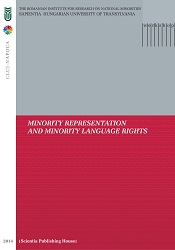Ethnic Structure and Minority Rights in the Inter-War and Post-Soviet Estonia and Latvia
Ethnic Structure and Minority Rights in the Inter-War and Post-Soviet Estonia and Latvia
Author(s): Ádám Németh, Áron Léphaft
Subject(s): Politics / Political Sciences, Law, Constitution, Jurisprudence
Published by: Scientia Kiadó
Summary/Abstract: The Baltic region plays the role of a special macro-region on our continent: it constitutes a bridge, however, sometimes a wall and fortress between Northern, Eastern and Central Europe. For hundreds of years, this peculiar geostrategic position has been determining the everyday life of the area’s inhabitants; thus, one of the oldest and most typical ‘geopolitical buffer zones’ as well as ‘ethnic contact zones’ is located here. During the 19th-20th centuries, an almost unexampled mix of ethnic groups lived in this area; little wonder that managing minorities was a serious challenge for the small independent Baltic countries during the inter-war period and it is one of the most serious challenges in the post-Soviet Baltics as well. The ‘journey’ of Estonia, Latvia and Lithuania from former Soviet republics towards European integration is disturbed by economic, political, social as well as ethnic problems, which first of all bear a relation to the Slavic minorities; remnants of a lost empire, the Soviet Union. As few decades before, the answers of these small countries to the similar questions are very different. For example, while the Estonian Cultural Autonomy of Ethnic Minorities Act (1925) was the first of its kind in the whole world and internationally recognized as a successful endeavour to protect the cultural autonomy of ethnic minorities, the Lithuanians were at war with the Poles because of Vilnius occupied by the Polish army in 1920. Since this region is still one of the ethnically most heterogeneous areas of Europe, the minority policies of – particularly – Latvia and Estonia are located constantly in the lime-light and are very often criticized by not only Russia but the European Union as well. The study seeks the answer when and how the ethnic structures and the minority policies evolved in the Baltic States during the first and second independence periods. Why did these countries apply different solutions in the case of similar challenges? Which are the most important lessons to be learned for the Central European minority policies?
Book: MINORITY REPRESENTATION AND MINORITY LANGUAGE RIGHTS
- Page Range: 241-262
- Page Count: 22
- Publication Year: 2014
- Language: English
- Content File-PDF

